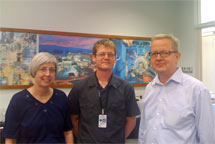
Handy Links
SLAC News Center
SLAC Today
- Subscribe
- Archives: Feb 2006-May 20, 2011
- Archives: May 23, 2011 and later
- Submit Feedback or Story Ideas
- About SLAC Today
SLAC News
Lab News
- Interactions
- Lightsources.org
- ILC NewsLine
- Int'l Science Grid This Week
- Fermilab Today
- Berkeley Lab News
- @brookhaven TODAY
- DOE Pulse
- CERN Courier
- DESY inForm
- US / LHC
SLAC Links
- Emergency
- Safety
- Policy Repository
- Site Entry Form

- Site Maps
- M & O Review
- Computing Status & Calendar
- SLAC Colloquium
- SLACspeak
- SLACspace
- SLAC Logo
- Café Menu
- Flea Market
- Web E-mail
- Marguerite Shuttle
- Discount Commuter Passes
-
Award Reporting Form
- SPIRES
- SciDoc
- Activity Groups
- Library
Stanford
Around the Bay
From the Director of Photon Science: A New Initiative in Catalysis and Interfacial Science at SLAC
In my SLAC Today Director's column last Friday, I discussed the many changes taking place in the Photon Science Directorate that position the lab for future growth and delivery of science essential for achieving future SLAC and Department of Energy missions. Today I am extremely pleased to announce an exciting next step in realizing those objectives, with the arrival of Jens Nørskov and a new initiative in catalysis and interfacial science being developed and lead by Jens.
Catalysts are widely used in many industrial processes, including energy production and mitigating pollution. New catalysts also hold the key to future energy technologies such as efficiently splitting water to form hydrogen or other fuels. To design these technologies, we first need to understand how catalysts carry out their function on the atomic level. We currently do not have a unifying predictive strategy (as for example the Standard Model provides for the field of high energy physics). Jens and his team are leading designers of new materials, especially for catalysis and energy storage applications, using advanced techniques of theory, modeling and simulation. Jens' new center at SLAC will provide a unique capability to understand and model new materials which can then be synthesized. Our light sources at SLAC (LCLS and SSRL) offer valuable techniques for characterizing the new materials. These materials can then be tested for improved catalytic properties with the ultimate goal of finding real world applications.
Jens and the first members of his research team have arrived at SLAC over the past few weeks. Jens assumes a joint faculty appointment between SLAC Photon Science and the Department of Chemical Engineering in Stanford University's School of Engineering. He will lead a new center initiative organized within our Chemical Sciences Division in the area of catalysis and interfacial science that is being supported by the DOE Office of Basic Energy Sciences.
Jens is a leading theoretical physicist and until now, Director of the Center for Atomic-scale Materials Design at the Technical University of Denmark. He arrives at SLAC with a scientific and operations team from Denmark. Staff Scientists Felix Studt and Frank Abild-Pedersen, and Associate Director for Administration Helle Wellejus will develop and support the new research portfolio. They will be joined by additional scientific staff in the future.
The focus of the new center will be to develop an understanding through advanced theory, modeling and simulation of the electronic and structural factors determining the properties of materials, leading to design of new materials with enhanced energy-relevant properties (including catalysis and energy storage capacity as mentioned above). Anders Nilsson will join the new center as deputy director and will be in charge of linking the theoretical activity to the experimental work at the Stanford Synchrotron Radiation Lightsource and Linac Coherent Light Source. An expansion of the experimental activities in interface science and catalysis is planned in the near future. In a future SLAC Today article, Jens will share with you in more detail his vision and objectives for his new center.

